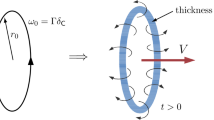Abstract
Self-similar flows of an incompressible fluid in a turbulent boundary layer, when the free-stream velocity is a power function (with the exponent m) of the longitudinal coordinate, have been studied. It has been shown that there are four different self-similar flow regimes corresponding to four individual similarity parameters one of which is the known Clauser parameter and the three other parameters have been established for the first time. At adverse pressure gradient, when the exponent m lies in a certain range depending on Reynolds number, the problem has two solutions with different values of the boundary-layer thickness and skin friction; consequently, hysteresis in a pre-separation flow is possible. Separation occurs not at the minimal value of m that corresponds to the strongest adverse pressure gradient, but at m = −0.216 −0.4 Re −1/3 p + O(Re −2/3 p ), where Re p is the Reynolds number based on longitudinal pressure gradient. The theoretical results are in good agreement with experimental data.
Similar content being viewed by others
References
A. A. Townsend, The Structure of Turbulent Shear Flow (Cambridge University Press, New York, 1976).
F. H. Clauser, J. Aeronaut. Sci. 21, 91 (1954).
F. H. Clauser, Adv. Appl. Mech. 4, 1 (1956).
H. Tennekes and J. L. Lumley, A First Course in Turbulence (MIT Press, Cambridge, Massachusetts, United States, 1972).
J. C. Rotta, Prog. Aerosp. Sci. 2, 3 (1962).
W. H. Schofield, J. Fluid Mech. 113, 91 (1981).
G. L. Mellor and D. M. Gibson, J. Fluid Mech. 24, 225 (1966).
P. Bradshaw, J. Fluid Mech. 29, 625 (1967).
L. F. East, W. G. Sawyer, and C. R. Nash, Tech. Rep.— R. Aircr. Establ. (G. B.), No. 79040 (1979).
M. R. Head, J. Fluid Mech. 73, 1 (1976).
B. Scheichl and A. Kluwick, in Progress in Turbulence, Ed. by J. Peinke, A. Kittel, S. Barth, and M. Oberlack (Springer-Verlag, Berlin, 2005), Ch. 3, p. 111.
I. I. Vigdorovich, J. Exp. Theor. Phys. 117(2), 356 (2013).
I. I. Vigdorovich, Dokl. Phys. 48(9), 528 (2003).
I. I. Vigdorovich, J. Exp. Theor. Phys. 99(5), 1028 (2004).
I. I. Vigdorovich, J. Exp. Theor. Phys. 101(4), 741 (2005).
I. I. Vigdorovich, J. Exp. Theor. Phys. 104(6), 972 (2007).
I. I. Vigdorovich, Izv. Akad. Nauk, Mekh. Zhidk. Gaza, No. 4, 106 (1993).
Th. von Kármán, in Mechanische Ähnlichkeit und Turbulenz, Proceedings of the Third International Congress Applied Mechanics, Stockholm, Sweden, August 24–29, 1930, Vol. 1, Ed. by C. W. Oseen and W. Weibull (Aktiebolaget Sveriges Litografiska Tryckerier, Stockholm, Sweden, 1931), pp. 85–93.
P. E. Skåre and P.-Å. Krogstad, J. Fluid Mech. 272, 319 (1994).
B. A. Kader and A. M. Yaglom, Itogi Nauki Tekh., Ser.: Mekh. Zhidk. Gaza 18, 3 (1984).
M. Van Dyke, Perturbation Methods in Fluid Mechanics (Academic, New York, 1964; Mir, Moscow, 1967).
P. Bradshaw and D. Ferriss, Natl. Phys. Lab. Aeronaut. Rep., No. 1145 (1965).
P. Bradshaw, Natl. Phys. Lab. Aeronaut. Rep., No. 1184 (1966).
P. S. Andersen, W. M. Kays, and R. J. Moffat, Rep. HMT-15, Stanford Univ. (1972).
B. S. Stratford, J. Fluid Mech. 5, 17 (1959).
A. F. Orlando, R. J. Moffat, and W. M. Kays, Rep. HMT-17, Stanford Univ. (1974).
M. Skote, D. S. Henningson, and R. A. W. M. Henkes, Flow, Turbul. Combust. 60, 47 (1998).
R. E. Melnik, Comput. Fluids 17(1), 165 (1989).
G. N. Abramovich, Applied Gas Dynamics, 5th ed. (Nauka, Moscow, 1991), Ch. 1 [in Russian].
P. R. Spalart, J. Fluid Mech. 187, 61 (1988).
S. Hoyas and J. Jimenez, Phys. Fluids 18, 011702-1 (2006).
H. Ludwieg and W. Tillmann, Ing.-Arch. 17, 288 (1949).
W. J. Bauer, PhD Thesis (State University of Iowa, Iowa City, United States, 1951).
H. J. Herring and J. F. Norbury, J. Fluid Mech. 27, 541 (1967).
Author information
Authors and Affiliations
Corresponding author
Additional information
Original Russian Text © I.I. Vigdorovich, 2014, published in Zhurnal Eksperimental’noi i Teoreticheskoi Fiziki, 2014, Vol. 146, No. 5, pp. 1062–1089.
Rights and permissions
About this article
Cite this article
Vigdorovich, I.I. Self-similar turbulent boundary layer with imposed pressure gradient. Four flow regimes. J. Exp. Theor. Phys. 119, 933–957 (2014). https://doi.org/10.1134/S1063776114110193
Received:
Published:
Issue Date:
DOI: https://doi.org/10.1134/S1063776114110193




